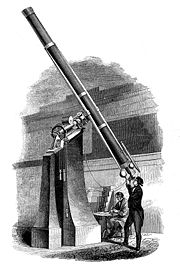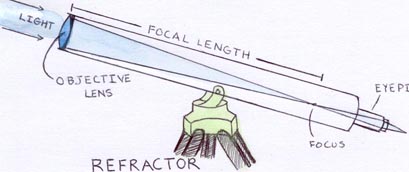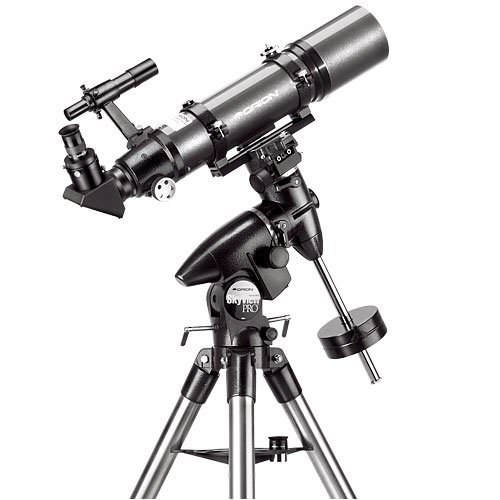If you ask someone to describe or draw a telescope, nine times out of ten it will be a refractor.
The refractor telescope is quite possibly the most common or easily recognized telescope. It is a very simple design, which has been around for hundreds of years.
The history of the refractor is that it was first invented in the Netherlands in 1608, and is credited to 3 individuals; Hans Lippershey, Zacharias Janssen – spectacle-makers and Jacob Metius.
In 1609 Galileo Galilei heard about the refracting telescope and made his own design, publically announcing his invention and further developing it through extensive experimentation. Galileo’s friend Johannes Kepler further experimented with the design, introducing convex lenses at both ends, improving the operation of the telescope.
Many advances were made and the refracting telescope became the primary instrument for astronomical observations, but there was one problem; they were huge and some were many tens of feet long!
But now, after more than 400 years and — luckily — through advances in know-how and technology, the refractor has become much more powerful and compact than some of the behemoths in the early days.
Refractors or refracting telescopes employ a simple optical system comprising of a hollow tube with a large primary or “objective lens” at one end, which refracts light collected by the objective lens and bends light rays to make them converge at a focal point.
Light waves which enter at an angle converge on the focal plane. It is the combination of both which form an image that is further refracted and magnified by a secondary lens which is actually the eyepiece. Different eyepieces give different magnifications.
The larger the size of the objective or primary lens = more light gathered. So a 6 inch refractor gathers more light than a 2 inch one. This means more detail can be seen.
There are two main types of refractor telescopes: “Chromatic” – entry level and upwards with 2 lens elements and “Apochromatic” – premium, advanced and expert level telescopes with 3 or more very high quality lens elements with exotic mixes of materials.
Chromatic refractor telescopes are particularly good for observing bright objects such as the moon, planets and resolving things like double stars, but many astronomers who image deep sky and other objects use very high quality apochromatic refractors, due to their superior optics.
Refractor telescopes are very low maintenance due to being a sealed system and it is a simple case of setup and enjoy, without the fiddling lengthy setup times you may get with other telescopes.
Refractors give clean and crisp views due to the sealed nature, unlike other telescopes like Newtonians which are subject to cooling and air turbulence issues.
Due to their small size they are very portable and can also be used for terrestrial observations the same as binoculars, which are basically two refractors bolted together.





I think you mean “acrhomatic” and “apochromatic” in this review. Achromatic telescopes are the common department store kind, using lenses made from an achromatic pair of flint glass and crown glass elements. Apochromatic telescopes employ lenses made from at least three pieces of glass with different indices of refraction.
If you didn’t know, “Chromatic” telescopes are okay for casual observing, but an “Apochromatic” scope, although more expensive, is worth the investment! Lens material is part of this equation. Lens can be made out of Fused Silica and Fused Quartz material, which come in Commerical, Optical, UV and IR grades. It goes without saying, but the better the glass and the better the coatings the more a refractor will cost…
The title of this page is erroneously “Reflector Telescopes.”
My glasses alone produce enough chromatic aberration to render the stars almost invisible. No, thank you!
Having that third lens to reduce chromatic aberration makes a huge difference, even on smaller refracting telescopes. Obviously, as others have stated, the better the lens material the better the image/view, but even the low end ones improve over simple two lens refractors.
Actually, high-quality “ED” refractors using two objective elements made of special low-dispersion glass can give near color-free performance. While 3-lens APOs give a “10” performance, they are the most costly ($400-$1,000 per inch of aperture) and are heavy. Quality ED scopes are less expensive ($200-$300 per inch of aperture) for 80-mm and 102-mm class scopes. I would rate their performance at “9” to “9.5” for visual use (less critical than for those who image). The lenses used in ED or APO scopes will have full multicoatings that cheaper scopes will not. High-quality refractors will also sport dual-speed Crayford focusers. Installing a FeatherTouch or Moonlight focuser will typically add $300 to the cost of a scope with a generic dual-speed focuser. Also note that high-quality refractors do not come with diagonals. A 2-inch dialetric diagonal will cost between $140 and $180. Traditional refractor tubing was steel or thick gauge aluminum. Newer designs are employing carbon fiber, which reduces weight considerably. Quality scopes do not come with eyepieces. (This is a whole other area. Poor eyepieces with a great scope will give mediocre results.)
Following is a very good “entry level” ED-scope:
>Stellarvue 80ED Raptor (carbon fiber tube) with dual-speed rotating focuser, collar and Vixen style mounting plate, collapsible dew shield, and case: $600
>Stellarvue 2″ dialectric diagonal: $140 if purchased with scope
>Vixen PortaMount 2 (a sturdy but lightweight alt-az mount): $330
As you can see, a high-quality ED scope and mount will cost about $1,100 (about 3-4 times of a “budget refractor” that includes the mount), but the setup described above will last with care for 20-30 years and give performance the cheap scopes can never match.
Indeed… eyepieces are key! A borrowed $500 TeleVue eyepiece turned my little 4″ Meade S/C into a whole new telescope!